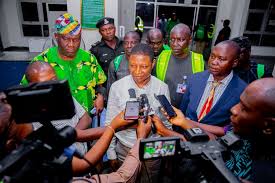The gubernatorial election in Ekiti State has come and gone into the graveyard of political history with applause and overwhelming acceptance from stakeholders. Contrary to expectations the election was very successful. It is necessary to say that Professor Attahiru Jega has done it again. His first outing as Chairman of the Independent Electoral Commission (INEC) in 2011 general elections was also successful.
The challenges of the Anambra election made Jega and his team to provide appropriate solutions to weaknesses in the Ekiti election which were related to supervision and coordination. This means Jega and INEC have crossed the hurdle of inefficiency and can occupy more to the class of successful election Management Bodies in Africa. While it is true that two or more elections are not similar in relation to infrastructure and behaviour of stakeholders, the Jega-led commission has a lot more to learn from Ekiti election. The lessons include activities of INEC and stakeholders in all the period of election – pre-election day, election day and post-election day.
INEC, before the election, published the basic statistics to assist stakeholders and election observation missions. These data are: 16 local government areas; 73266 registered voters out of which 476870 collected permanent Voters Card. The 200,000 voters who did not collect permanent voters’ card are not eligible to vote. Others include 177 wards; 101 registration areas, 57 super registration areas, 177 result collection centers.
Ado-Ekiti, the state capital, has the largest voting population of 131,141 registered voters and 297 polling units and 455 voting points. Those who are responsible for providing personnel for the election include INEC, security organizations and election observation missions. INEC deployed 8433 staff made up of Resident National Commissioners and ad-hoc staff. Ad-hoc staff were involved in issues of accreditation of voters and conduct of polls; while commissioners performed functions of coordination and supervision. Police deployed 12000 officers while the Civil Defence Corps deployed 15000 officers. Over 1000 election observers were deployed. Observer missions were from Transition Monitoring Group (TMG), UNDP/DGD, EU, British High Commission, US Embassy, Embassies of the Netherlands, Switzerland and France.
Only 18 political parties fielded candidates for the election. The three front runners were Dr Peter Kayode Fayemi (APC), Mr. John Ayo-Fayose (PDP) and Hon Opeyemi Bamidele (LP).
The result of the election was overwhelming victory for PDP’s Fayose with 120433(APC), 18125(LP) and 203099 (PDP). Fayose won in all the 16 local government areas of the state. The election was free and fair. This was confirmed by local and international observation missions.
The lessons from the election are many as polls counting, collation, tabulation and announcement and declaration of results where within the deadline. They were minor hitches which did not affect the overall conduct and outcome of the election. INEC should repeat this template in the forthcoming election in Osun State and the 2015 general election.
In terms of party competition it was a battle between elite and the masses. Against his background of good education and long service with the democratic movement the incumbent governor brought to Ekiti State rocket science, public sector administration and digital method of analysis based on power-point presentation. This is why his major policies were based on top bottom approach with little relevance to the needs of the masses. Fayemi made a strategic political mistake by not constituting elected local government councils throughout his four-year in government. This created a disconnect between him and the masses. Chairmen and councilors of local governments were not available to mobilize the masses at the crucial period of the election.
On the other hand, Fayose, who started as an underdog focused on two factors which eventually assisted him to win the election, i.e. mobilization of the masses and “Amala politics”. He was obviously a student of late Chief Lamidi Adedebu when he was a young man in Ibadan. He learnt that mobilization of the people and the use of economic resources are necessary for outcome of election in Nigeria. Other examples of those who employed the strategy are Rochas Okorocha in Imo State and Adams Oshiomhole in Edo State.
Another important factor in the Ekiti Election is the post-election reaction by both the victorious and the defeated candidates. Governor Fayemi surprised Nigerians when he congratulated Fayose and released his concession speech. Fayose replied with an olive leaf branch message inviting Fayemi to cooperate with him to move Ekiti State forward. Election, according to him, is over and it is time to build Ekiti. This requires collective effort of citizens in the state. This prevented violence by supporters of the major political parties. It is an important development in the electoral politics of Nigeria and should be encouraged.
The election in Osun State is scheduled for August which is just one month from now, a short period for preparation for election. In view of the foregoing, INEC should move its victorious army to Oshogbo and repeat the magic of Ekiti. The watch word for INEC should be “Forward ever backward Never”.



